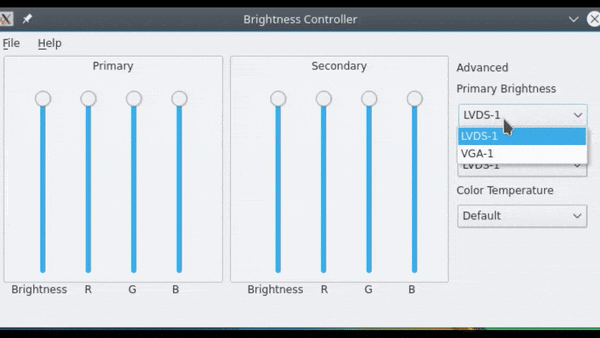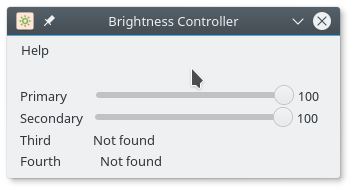This is version 2.3.4 of Brightness Controller, ported to Python 3 and QtPy. It supports an arbitrary number of displays!
If you like this, do not forget to give us a Star! 
Thanks to package maintainer @apandada1, we have PPA repository For Ubuntu and likewise users:
sudo add-apt-repository ppa:apandada1/brightness-controller
sudo apt update
sudo apt install brightness-controllerThanks to @yochananmarqos, a package for Arch and derivatives is available in the AUR.
yay -S brightness-controller-gitFirst, install QtPy.
sudo apt install python3-qtpySometimes it is not enough to install and integrate QtPy, so you might also try installing QtPy using pip3.
pip3 install qtpyQtPy is a wrapper that works by using PyQt or PySide.
It needs either of these to work, and some operating systems come with either of these preinstalled, and some do not.
If your system does not have either of these, you may need to install either PySide or PyQt. For example, you may have to execute the following:
pip install PySide2Please check Requirements section for missing dependencies. We prefer using --user while installing QtPy (and its other dependencies) using pip. Installing it in virtual environment may not work as intended.
Next, download the latest zip file from here.
Extract it and open a terminal. Change directory to the Brightness folder. Next type this command:
python3 src/init.pyAchean also created a detailed tutorial on how to install it in Debian based on his experience. You can find it here.
The following features are implemented:
- Brightness Control
- Saving color profile
- Loading color profile
We are working on the following features and plan to release these through version 3:
- Rewriting GUI to integrate both Brightness Controller simple and normal
- Auto-loading of color and brightness settings based on profile
- Checking for update
Brightness Controller changes Red, Green and Blue color ratios in the screen through color profile at software level using xrandr.
We work on this in our spare time, so can not really promise when the v3 will be released. The current version available is stable and should work as intended.
There are several requirements:
- python3
- python3-qtpy
- xrandr support in your system
python3-qtpy is a wrapper around Qt for Python. You will need either PyQt5, PyQt4, PySide2 or PySide installed in your system.
Please test v2.3. Reporting bugs is appreciated.
We got you covered! Try version 1.2.8/simpler version of Brightness Controller.
To install, simply do this:
sudo add-apt-repository ppa:apandada1/brightness-controller
sudo apt-get update
sudo apt-get install brightness-controller-simpleFurther details are available here Please note that the simple version may not work properly in newer versions of Linux. Unfortunately we can not provide any more updates to the simple version.

